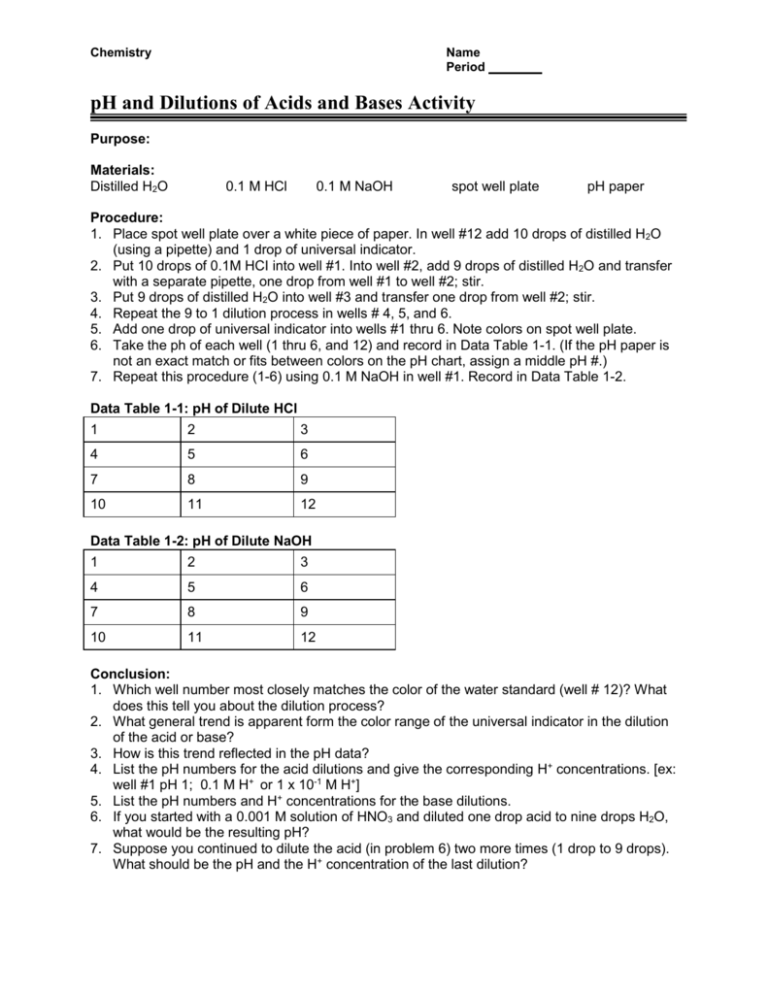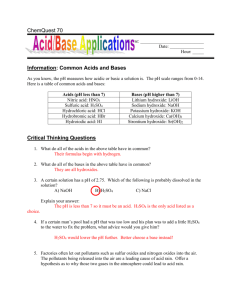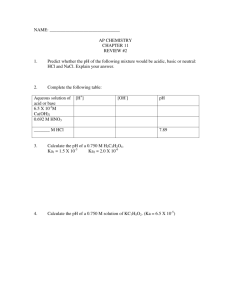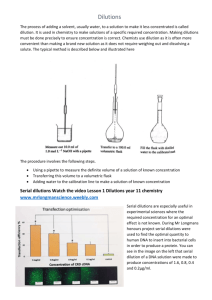pH and Dilutions of Acids and Bases
advertisement

Chemistry Name Period pH and Dilutions of Acids and Bases Activity Purpose: Materials: Distilled H2O 0.1 M HCl 0.1 M NaOH spot well plate pH paper Procedure: 1. Place spot well plate over a white piece of paper. In well #12 add 10 drops of distilled H2O (using a pipette) and 1 drop of universal indicator. 2. Put 10 drops of 0.1M HCI into well #1. Into well #2, add 9 drops of distilled H2O and transfer with a separate pipette, one drop from well #1 to well #2; stir. 3. Put 9 drops of distilled H2O into well #3 and transfer one drop from well #2; stir. 4. Repeat the 9 to 1 dilution process in wells # 4, 5, and 6. 5. Add one drop of universal indicator into wells #1 thru 6. Note colors on spot well plate. 6. Take the ph of each well (1 thru 6, and 12) and record in Data Table 1-1. (If the pH paper is not an exact match or fits between colors on the pH chart, assign a middle pH #.) 7. Repeat this procedure (1-6) using 0.1 M NaOH in well #1. Record in Data Table 1-2. Data Table 1-1: pH of Dilute HCl 1 2 3 4 5 6 7 8 9 10 11 12 Data Table 1-2: pH of Dilute NaOH 1 2 3 4 5 6 7 8 9 10 11 12 Conclusion: 1. Which well number most closely matches the color of the water standard (well # 12)? What does this tell you about the dilution process? 2. What general trend is apparent form the color range of the universal indicator in the dilution of the acid or base? 3. How is this trend reflected in the pH data? 4. List the pH numbers for the acid dilutions and give the corresponding H+ concentrations. [ex: well #1 pH 1; 0.1 M H+ or 1 x 10-1 M H+] 5. List the pH numbers and H+ concentrations for the base dilutions. 6. If you started with a 0.001 M solution of HNO3 and diluted one drop acid to nine drops H2O, what would be the resulting pH? 7. Suppose you continued to dilute the acid (in problem 6) two more times (1 drop to 9 drops). What should be the pH and the H+ concentration of the last dilution? Acids and bases 3 Write complete and balanced equations for each of the following reactions. 1. HF + KOH 2. HNO2 + NaOH 3. HClO3 + Be(OH)2 4. H2SO4 + LiOH 5. H3PO4 + Al(OH)3 6. HNO3 + Ba(OH)2 7. H2Se + Ca(OH)2 8. H3PO4 + Mg(OH)2 9. HNO3 + NH3 10. H2CO3 + NH3 Write a balanced equation and then calculate the following titration problems. Show work on a separate sheet of paper. 11. A 45.0 mL sample of HNO3 is titrated to its end point with 25.2 mL of 2.50 M KOH. What is the concentration of the HNO3? 12. A 50.0 mL sample of HBr is titrated to its end point with 21.0 mL of 1.50 M NaOH. What is the concentration of the HBr? 13. What is the molarity of a NaOH solution if 38.0 mL of the solution is titrated to its end point with 14.0 ml of 0.750 M H2SO4? 14. If 18.6 mL of a Ca(OH)2 solution is completely neutralized by 19.8 mL of 0.0100 M H2SO4, what is the concentration of the calcium hydroxide solution? 15. What volume of 0.12 M barium hydroxide is needed to neutralize 12.2 mL of 0.25 M HCl? 16. Forty-five mL of a cleaner containing potassium hydroxide was neutralized with 32.2 mL of 0.75M HCl. What is the concentration of the KOH in the cleaner? 17. An ammonia-based cleaner with a volume of 65.5 mL was neutralized with 16.2 mL of 1.20 M of HNO3. What is the molarity of the ammonia in the container? 18. A cleaner containing sodium hydroxide with a volume of 35.2 mL was neutralized with 25.4 mL of 2.50 M nitrous acid? 19. What is the molarity of 55.3 ml of sulfuric acid when it is titrated to its end point with 122.7 mL of 0.75 M calcium hydroxide? 20. Determine the concentration of 17.2 mL of acetic acid if it is neutralized with 11.5 mL of 2.25 M lithium hydroxide.








